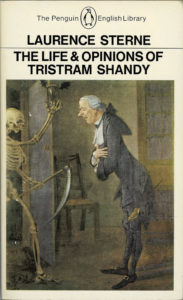In my copy of Tristram Shandy, pages 23 to 68 came loose and I joked about mixing them up and reading them in a random order, but it doesn’t work. There is order to the disorder, organization to the chaos.

Tristram is constantly interrupting himself to explain the background to each event, events which need further explanations and digressions, and so on, and yet the story still moves forward, very, very slowly. Tristram says, “In a word, my work is digressive, and it is progressive too,—–and at the same time . . . I have constructed the main work and the adventitious parts of it with such intersections, and have so complicated and involved the digressive and progress movements, one wheel within another, that the whole machine, in general, has been kept a-going” (63).
Digressions, he says, are the life and soul of reading, if you “take them out of this book, for instance,——you might as well take the book along with them” (63), true enough since there are nothing but digressions. Why so many digressions? He says, “when a man sits down to write a history . . . he knows no more than his heels what lets and confounded hinderances he is to meet with in his way” (36), and then he lists the difficulties a writer has to deal with:
“Accounts to reconcile:
Anecdotes to pick up:
Inscriptions to make out:
Stories to weave in:
Traditions to sift:
Personages to call upon:
Panegyrics to paste up at this door:” (37).
Writing is much slower than life. Tristram Shandy, who had written thirteen chapters in his autobiography, said, “I have been at it these six weeks, making all the speed I possibly could,——and am not yet born:—–I have just been able, and that’s all to tell you when it happened, but not how” (37). By the time he gets himself born, he realizes that he has another year more to write about than when he started, so that he is actually falling behind rather than catching up to himself. Life outpaces writing.
Similarly, I am still writing about the book I finished reading weeks ago, Laurence Sterne’s masterpiece of metafiction, and I could go on writing about it for years without giving more than a limited introduction to the metafictional elements of the novel. But this is all a digression for I am not writing about my own writing. I am writing about digressions in Tristram Shandy and I need to keep moving forward.
(Check out my posts: Tristram Shandy ****s Up the Page, The Stuff That Dreams are Made of: Paper, Ink, Letter and Word, This is not the name of another post about Tristram Shandy, History is an Angel Blown Backward Through Time.)To read more about metafiction, check out my book Narrative Madness, available at narrativemadness.com or on Amazon.)
Work Cited
Sterne, Laurence. Tristram Shandy. New York: The New American Library of World Literature, Inc., 1960.
Interesting. When I read your facebook post, “Am I moving backward or forward?” My first thought was “probably in a circle,” because I think life is a cycle, an eternal round. So it was particularly interesting to read the quote above, “one wheel within another.” But maybe, like the “whole machine” mentioned above, there are both linear and cyclical aspects to movement through time and space.
A couple thoughts:
1- Are you familiar with William S Burroughs’ cut-up method? Or the chance operations of John Cage? Both tried to sidestep rationality, intention, and logical philosophy by making use of randomness in their compositions. I think they also both had a somewhat mystical idea of gaining insight into some hidden order, or at least the subconscious.
2- It’s also interesting that putting the pages back together in the correct order is a certain work that you have to perform in order to forestall chaos. This fits in quite well with the themes of the book, I think, about how hard it is to impose order on those slippery words.